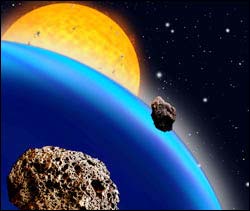This area deals with the fundamental laws and building blocks of nature and how they interact, the properties and the behavior of matter, and research into space and time and their structures.
innovations-report provides in-depth reports and articles on subjects such as astrophysics, laser technologies, nuclear, quantum, particle and solid-state physics, nanotechnologies, planetary research and findings (Mars, Venus) and developments related to the Hubble Telescope.

Fifteen years ago, the largest telescopes in the world had yet to locate a planet orbiting another star. Today telescopes no larger than those available in department stores are proving capable of spotting previously unknown worlds. A newfound planet detected by a small, 4-inch-diameter telescope demonstrates that we are at the cusp of a new age of planet discovery. Soon, new worlds may be located at an accelerating pace, bringing the detection of the first Earth-sized world one step closer.

A new class of water-soluble quantum dots made from small numbers of gold atoms could be the basis for a new biological labeling system with narrower excitation spectra, smaller particle size and fluorescence comparable to systems based on semiconductor quantum dots.
Providing the “missing link” between atomic and nanoparticle behavior in noble metals, these multi-electron “artificial atoms” could also serve as light-emitting sources in nanoscale optoelectronics and in energy tr

Using a network of small telescopes and the “transit method” of detection, scientists have made their first direct discovery of a planet orbiting a bright star. A periodic dimming of light from a bright star 500 light-years away revealed the planet’s presence. The star’s intense light will allow scientists to explore the chemical makeup of the planet’s atmosphere in future observations. A paper on the recent discovery will appear on-line today in The Astrophysical Journal Letters.

The International Committee for Future Accelerators (ICFA) announced at a scientific conference in Beijing that the planned International Linear Collider (ILC) is to be realized in superconducting technology. This decision is of great importance for DESY and its international partners, since they developed this technology together and successfully tested it at the TESLA Test Facility (TTF) in Hamburg. The ILC is the next major project of particle physics. No decision has yet been taken on the r

Readings done by a Canadian-Austrian team present a puzzle for astronomers. Expected surface phenomena, which provide information about stellar structures, could not be evidenced from readings obtained by means of a Canadian microsatellite. The precise satellite readings leave no doubt on the data published in NATURE. The project, organised in co-operation with the Institute of Astronomy at the University of Vienna and supported by the Austrian Science Fund (FWF), challenges the existing unders

The first sighting of atoms flying in formation has been reported by physicists at the Department of Commerce’s National Institute of Standards and Technology (NIST) and the University of Colorado at Boulder (CU-Boulder) in the Aug. 13 issue of Physical Review Letters*. While the Air Force and geese prefer a classic “V,” the strontium atoms–choreographed in this experiment with precision laser pulses and ultracold temperatures–were recorded flying in the shape of a cube.
This “rea